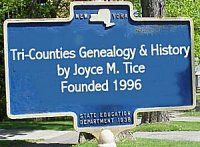|
| The History Center on Main Street, 83 N. Main Street, Mansfield PA 16933 histcent83@gmail.com |
|

The Reformatory was one of the most popular subjects on Elmira Postcards in the early Twentieth Century |
|
|
THE NEW YORK STATE REFORMATORY
By HELEN M. SAMSON
Since The days when public executions were an accepted form of public entertainment, and wrong doers were thrust into jails that were horrible to contemplate, some people were convinced that there must be a better way. A felon who had served a term in jail was seldom a better man for the experience and the publicity of the executions never seemed a deterrent to the criminal tendencies of the avid viewers.
This thinking was expressed in fine old fashioned prose as, "Early in the 19th century, a reaction against sanguinary punishment produced the penitentiary system but so crude was it that in the first half of the century, it conceded failure."
Reformatory trade schools seemed to be an answer to the dilemma of what to do with young men convicted of their first crime. Here, they would be taught a trade and then could return to society ready for employment and the respect of the community.
In 1869, a law was enacted in the state of New York authorizing the establishment of an institution for the reception of male felons between the ages of 16 and 30, not previously convicted of any crime. This institution was to be located in the city of Elmira and the name was to be the New York State Reformatory at Elmira.
At that time, the State Comptroller was Lucius Robinson, an Elmirian who was in sympathy with these plans. He was influential in Albany and helped to procure the necessary funds. Mr. Robinson was later elected Governor of the state. Another man, Judge George Bradley of Corning was in favor of the plan and fathered the bill in the state Senate.
The site was selected on a hillside, seventy feet above the road and overlooking the valley. It was part of the old McCann holdings and consisted of 280 acres, said to be worth less for agriculture. The price paid was $38,052. On of the original homes of the McCann family can be seen on Oakwood Avenue with the old iron dog still guarding it. The house dates from 1817 but the dog came to stay in 1876.
Construction was started on the prison buildings by prisoners from Auburn Prison. When it was finished, the light gray structure with the towers could be seen from any elevation for many miles. A renovation project in 1930 changed the appearance and removed the well known towers and the big building is less visible on the landscape.
Mr. Zebulon Brockway was the first superintendent. His was an imposing figure and he was a well known and popular citizen of the city. He was elected mayor later in his career.
A good friend, Dr. Wilifred A. Booth often discussed the plans for the new Reformatory with Mr. Brockway and read the copious notes and articles that he had written. They were so complete that Dr. Booth urged the writer to extend them and publish them as a book. Mr. Brockway finally did this and sent a copy to his friend. This book is now in the library at the Chemung County Historical center. More interesting than the descriptions of the various methods used in the new facility are the margin notes written by Dr. Booth.
A paragraph describing the innovations used in the dining hall was noted. "I suggested these to Mr. B." – A.W. Booth. These new ideas were really something new in facilities for the criminal. White cloths were used on small tables, good plain crockery was used and the men ordered their meal from a printed menu. A far cry from the days of bread and water and a small touch of proper living for boys who may have seen very little of that in their homes and community.
On another margin, he wrote, "Mr. Brockway requested me to go to Europe at his expense to study diet and its possible effect on the criminal. I declined and explained that I had no hope that diet could change a criminal." – A. W. Booth.
Although diet changes were not used to change the attitudes of the young members of the Reformatory family, study and training were tried. A fellow sent to Elmira for his term had a choice of a large range of professions. He could be a painter, a tinsmith, a bookbinder, a sign painter or an upholsterer. He could have training in a number of other vocations and later, when a farm was added he might learn how to care for the pure bred Holstein herd that supplied milk for the institution. A farm that produces Christmas trees was a later possession of the institution.
Many changes have come about in the old Reformatory. It is now the Reception Center but the purposes of the place are about the same – to send a young man back to his home a little bit better equipped to face the world as he finds it and, hopefully, able to stay out of those grim gray walls in other towns in later years.
| The Reformatory shown in the background from Woodlawn National Cemetery - Photo by Joyce M. Tice 01 MAY 2001 |  |
 |
First Added to the Site on 16 DEC 2002
By Joyce M. Tice Email: JoyceTice@aol.com You are the visitor since the counter was installed on 16 DEC 2002 |
| The History Center on Main Street, 83 N. Main Street, Mansfield PA 16933 histcent83@gmail.com |